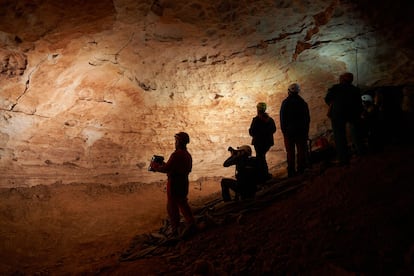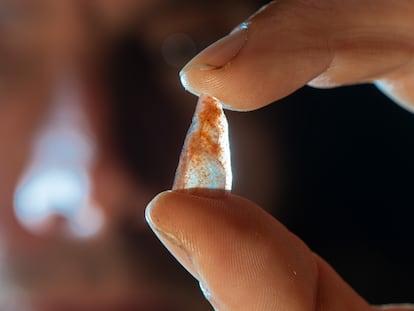Over 100 prehistoric engravings found in a cave in northeastern Spain
The art has been described as “exceptional, both for its singularity and excellent state of conservation” by the team that discovered it inside Cova de la Vila

More than 100 prehistoric engravings have been discovered, arranged on an eight-meter panel, inside the cave known as Cova de la Vila, in La Febró (Tarragona), in Spain’s northeastern region of Catalonia. The depictions found in the Mediterranean underground gallery have been described as “exceptional, both for their singularity and for their excellent state of conservation” by a team from the Catalan Institute of Human Paleoecology and Social Evolution (IPHES).
According to IPHES specialist Ramón Viñas, this mural represents the world view of first farmer societies during the Chalcolithic-Bronze age. The engravings were first discovered on May 13, 2021 by a group of three cave explorers and subsequently underwent analysis by archaeologists and palaeontologists from IPHES, the institute said in a statement.
Among the cave art samples, there are representations of different figures of quadrupeds, zigzags, linear, angular and circular lines, and a series of zoomorphs (possibly bovids and equines), star shapes and reticular lines. The discovery of the cave art constitutes “one of the few representations of underground schematic art in the entire Mediterranean Arc,” said the regional government of Catalonia.
The discovery marks “a historic milestone for prehistoric archaeology,” according to IPHES.
The cave had been explored by Salvador Vilaseca in the 1940s, but its location had been lost. IPHES researchers managed to open a small hole between blocks of stone and came into an oval room of more than 90 square meters.
The first person to enter was Juli Serrano, who, to his surprise, saw a “mural full of lines and figures.” He says that when he came into the large, circular cavity and saw what it contained, he felt “a very great emotion, which I will take with me for life.” Without knowing it, he had just discovered one of the most important assemblages of prehistoric cave art. From that moment on, researchers Ramon Viñas and Josep Vallverdú from IPHES got to work on the site.
Viñas underscored how the panel of engravings is structured along five horizontal lines, one on top of the other, and how each of them contains different engraved figures that have their own meaning and symbolism. The scientist points out that it is an “absolutely unusual” composition that indicates “a worldview on the part of the populations of the territory during the neolithization process.”
One of the singularities is that this cave art was made “exclusively with the engraving technique,” using a stone or wooden tool or directly with the fingers, explained Viñas. The researcher considers that this, as well as the fact that it is “stylistically very homogeneous,” indicates a symbolic meaning. It is not a composition that is the result of chance.
During the transition period between the Chalcolithic and the Bronze Age, between the late 5th and the late 3rd millennia BC, human groups were generally found outdoors, their presence being very scarce in the underground cavities of Catalonia, in the northeast of the Iberian peninsula. Elsewhere in Spain, instances of underground dwellings have also been found in Andalusia, Segovia, Burgos and Soria.
To guarantee its conservation, the regional government has closed access to Sala dels Gravats (Engravings Room). The site has been designated a cultural asset of national interest and work is underway to create a 3D model of the cave.
Sign up for our weekly newsletter to get more English-language news coverage from EL PAÍS USA Edition
Tu suscripción se está usando en otro dispositivo
¿Quieres añadir otro usuario a tu suscripción?
Si continúas leyendo en este dispositivo, no se podrá leer en el otro.
FlechaTu suscripción se está usando en otro dispositivo y solo puedes acceder a EL PAÍS desde un dispositivo a la vez.
Si quieres compartir tu cuenta, cambia tu suscripción a la modalidad Premium, así podrás añadir otro usuario. Cada uno accederá con su propia cuenta de email, lo que os permitirá personalizar vuestra experiencia en EL PAÍS.
¿Tienes una suscripción de empresa? Accede aquí para contratar más cuentas.
En el caso de no saber quién está usando tu cuenta, te recomendamos cambiar tu contraseña aquí.
Si decides continuar compartiendo tu cuenta, este mensaje se mostrará en tu dispositivo y en el de la otra persona que está usando tu cuenta de forma indefinida, afectando a tu experiencia de lectura. Puedes consultar aquí los términos y condiciones de la suscripción digital.
More information
Últimas noticias
Welcome to the post-religion era: The idea of Christianity as the absolute truth has become obsolete
‘I thought you would like it’: The risky sexual practice popularized by TV shows and TikTok
The digitalization of tourism: ‘They promise experiences and gave us the worst possible one’
Mexican peso defies uncertainty with forecasts of a new period of stability in 2026
Most viewed
- Sinaloa Cartel war is taking its toll on Los Chapitos
- Reinhard Genzel, Nobel laureate in physics: ‘One-minute videos will never give you the truth’
- Oona Chaplin: ‘I told James Cameron that I was living in a treehouse and starting a permaculture project with a friend’
- Why the price of coffee has skyrocketed: from Brazilian plantations to specialty coffee houses
- Silver prices are going crazy: This is what’s fueling the rally











































